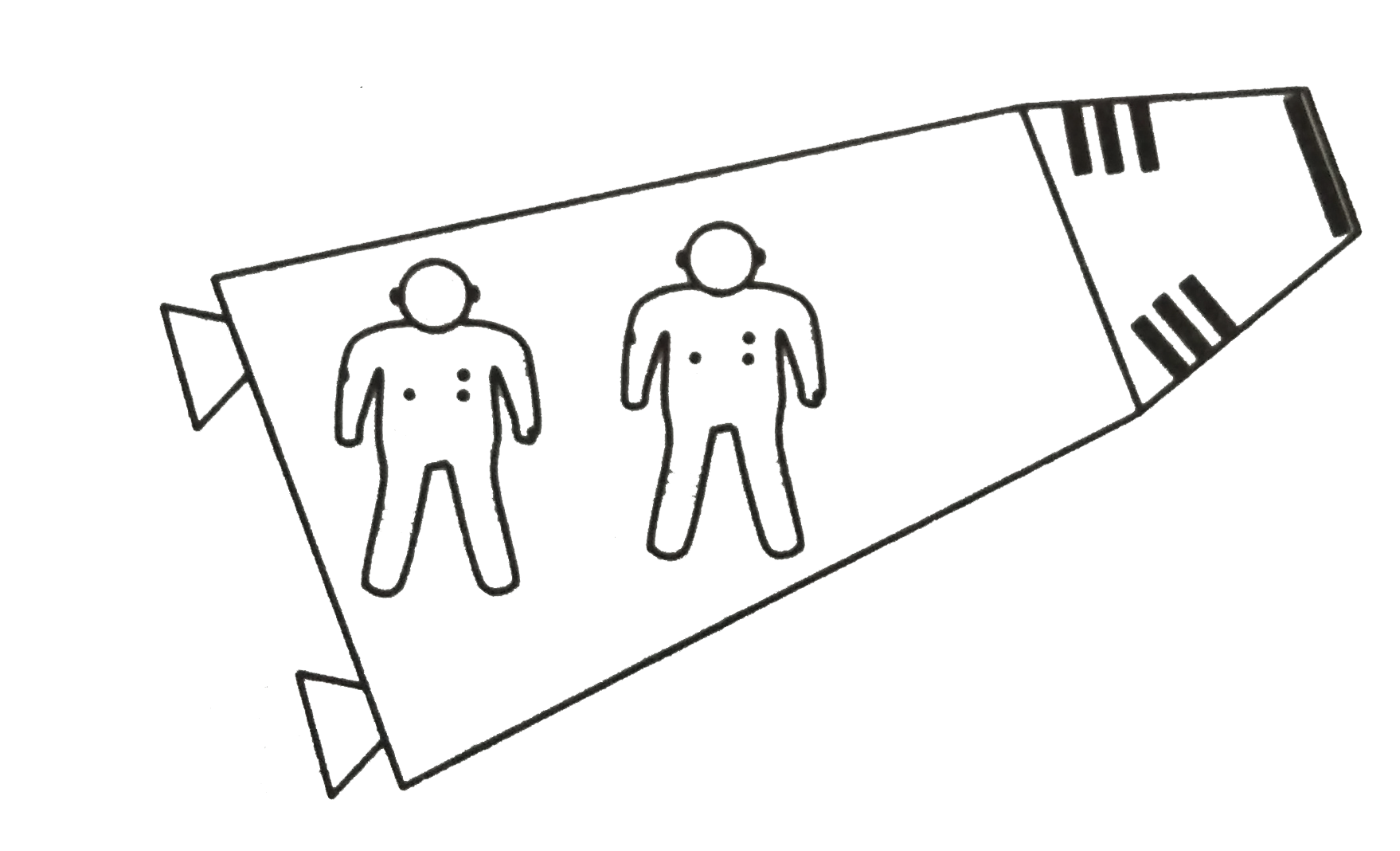A body at rest breaks into two pieces of equal masses. The parts will move
in same direction
along different lines
in opposite directions with equal speeds
in opposite directions with unequal speeds.
The correct Answer is:C
To solve the problem of a body at rest breaking into two equal masses, we can follow these steps:
1. Understanding the Problem:
- We have a body at rest that breaks into two pieces of equal mass.
- Let the mass of each piece be m.
- Since the body is initially at rest, its initial momentum is zero.
2. Initial Momentum:
- The initial momentum Pinitial of the body is given by:
Pinitial=0(since the body is at rest)
3. Final Momentum:
- After breaking, let the velocities of the two pieces be V and V′.
- The final momentum Pfinal of the system can be expressed as:
Pfinal=mV+mV′
4. Applying Conservation of Momentum:
- According to the law of conservation of momentum, the total momentum before the break must equal the total momentum after the break:
Pinitial=Pfinal
- Therefore, we have:
0=mV+mV′
5. Simplifying the Equation:
- We can factor out m (assuming m≠0):
0=V+V′
- This implies:
V=−V′
6. Interpreting the Result:
- The equation V=−V′ indicates that the two pieces move in opposite directions with equal speeds.
7. Conclusion:
- Thus, the final conclusion is that the two pieces will move in opposite directions with equal speeds.
Final Answer:
The parts will move in opposite directions with equal speeds.
---
- We have a body at rest that breaks into two pieces of equal mass.
- Let the mass of each piece be m.
- Since the body is initially at rest, its initial momentum is zero.
- The initial momentum Pinitial of the body is given by:
Pinitial=0(since the body is at rest)
- After breaking, let the velocities of the two pieces be V and V′.
- The final momentum Pfinal of the system can be expressed as:
Pfinal=mV+mV′
- According to the law of conservation of momentum, the total momentum before the break must equal the total momentum after the break:
Pinitial=Pfinal
- Therefore, we have:
0=mV+mV′
- We can factor out m (assuming m≠0):
0=V+V′
- This implies:
V=−V′
- The equation V=−V′ indicates that the two pieces move in opposite directions with equal speeds.
- Thus, the final conclusion is that the two pieces will move in opposite directions with equal speeds.
The parts will move in opposite directions with equal speeds.
Topper's Solved these Questions
- CENTRE OF MASS, LINEAR MOMENTUM, COLLISIONBook:HC VERMA ENGLISHChapter:CENTRE OF MASS, LINEAR MOMENTUM, COLLISIONExercise:Exercises
Explore 64 Videos
- CENTRE OF MASS, LINEAR MOMENTUM, COLLISIONBook:HC VERMA ENGLISHChapter:CENTRE OF MASS, LINEAR MOMENTUM, COLLISIONExercise:Question For short Answer
Explore 25 Videos
- CENTRE OF MASS, LINEAR MOMENTUM, COLLISIONBook:HC VERMA ENGLISHChapter:CENTRE OF MASS, LINEAR MOMENTUM, COLLISIONExercise:worked out Examples
Explore 23 Videos
- CALORIMETRYBook:HC VERMA ENGLISHChapter:CALORIMETRYExercise:Short answer
Explore 9 Videos
- CIRCULAR MOTIONBook:HC VERMA ENGLISHChapter:CIRCULAR MOTIONExercise:Question for short Answer
Explore 10 Videos
Similar Questions
A body falling vertically downwards under gravity breaks in two parts of unequal masses. The centre of mass of the two parts taken together shifts horizontally towards
View SolutionA body falling vertically downwards under gravity breaks in two parts of unequal masses. The centre of mass of the two parts taken together shifts horizontally towards
View SolutionA particle at rest suddenly disintegrates into two particles of equal masses which start moving. The two fragments will
View SolutionAn artifical satellite of mass m is moving in a circular orbit at a height equal to the radius R of the earth. Suddenly due to intensity explosion the satellite breakes into two parts of equal pieces. One part of the satellite stops just after the explosion. The increase in the mechanical energy of the system due to explosion will be
(Given, acceleration due to gravity on the surface of earth is g)
View SolutionAn object of mass 5 kg and speed 10ms−1 explodes into two pieces of equal mass. One piece comes to rest. The kinetic. Energy added to the system during the explosion is :
View SolutionA block at rest explodes into three equal parts. Two parts start moving along X and Y axes respectively with equal speeds of 10 m/s. Find the initial velocity of the third part.

View SolutionA particle of mass 4m is projected from the ground at some angle with horizontal. Its horizontal range is R. At the highest point of its path it breaks into two pieces of masses m and 3m, respectively, such that the smaller mass comes to rest. The larger mass finally falls at a distance x from the point of projection, where x is equal to
View SolutionA ball of mass m moving with a velocity v along X-axis, strikes another ball of mass 2m kept at rest. The first ball comes to rest after collision and the other breaks into two equal pieces. One of the pieces starts moving along Y-axis with a speed v1. what will be the velocity of the other piece?
View SolutionA bomb of mass 16kg at rest explodes into two pieces of masses 4 kg and 12 kg. The velolcity of the 12 kg mass is 4ms−1. The kinetic energy of the other mass is
View SolutionA body of mass m is moving in a circular orbit of radius R about a planet of mass M. At some instant, it splits into two equal masses. The first mass moves in a circular orbit of radius R2. And the other mass, in a circular orbit of radius 3R2. The difference between the final and initial total energies is :
View Solution
